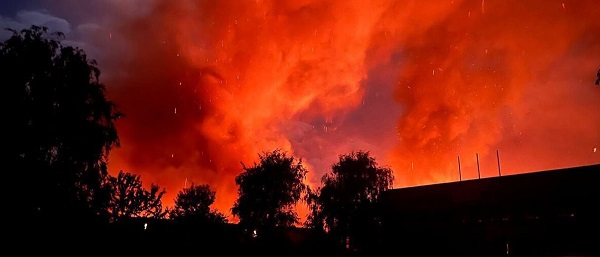conflict
High death toll does not mean Israel’s violating international law

From the MacDonald Laurier Institute
By Sarah Teich and Brian L. Cox
Many critics of Israel seem to be operating under a misunderstanding of the law of armed conflict.
The seven-day truce between Israel and Hamas ended on Dec. 1. Since the fighting resumed, calls to keep Israel accountable to international law have been intensifying, including, most recently, from Foreign Affairs Minister Mélanie Joly, who said that Canada will “support any form of accountability systems … at the international level that will look into” Israel’s conduct. On Tuesday, Canada voted for a ceasefire in Gaza at the United Nations, which will likely further embolden critics of Israel’s military operations.
Critics stand ready to lambaste Israeli military forces for the destruction of civilian infrastructure and civilian deaths, even accusing Israel of war crimes and genocide. Yet these criticisms often involve a distortion of the facts and a distortion of the law.
Oct. 7 was the single most brutal massacre against Jewish people since the Holocaust. The images and videos of the massacre are horrific. Women were paraded half-naked through the streets of Gaza; babies were ripped from the arms of their mothers and burned alive; elderly Holocaust survivors were terrorized and abducted. Approximately 1,200 people were killed and over 200 taken hostage in attacks orchestrated and carried out by Hamas, a recognized terrorist organization that receives funding and training from the Islamic Republic of Iran.
In the weeks that followed, and as Hamas continued to launch rockets indiscriminately at Israeli cities, Israeli forces initiated extensive ground, air and sea operations in Gaza, with the aim of dismantling Hamas and retrieving the hostages. These goals are, presumably, incredibly difficult for Israeli forces to achieve without risking harm to civilians, given that Hamas is known to use Palestinian civilians as human shields. Deaths in Gaza, according to local authorities, have surpassed 18,000.
There is a general prohibition on the use of force in international law. Unprovoked wars of aggression are illegal. States are, however, generally permitted to use force when acting in self-defence and with necessary, proportionate objectives. It is apparent that, following Hamas’s attack on Oct. 7 and continued indiscriminate rocket fire at Israel, Israel’s goal of dismantling Hamas and retrieving hostages would be considered necessary and proportionate objectives justifying the use of force. These strategic objectives comply with jus ad bellum, the body of law that governs when force may be initiated.
International humanitarian law, or jus in bello, governs the conduct of armed hostilities, even in the context of a lawful war. This is the law of war, or the law of armed conflict, and it applies to all parties to a conflict. Under the law of armed conflict (LOAC), the proportionality rule prohibits engaging in an attack “when the expected incidental loss of civilian life, injury to civilians or damage to civilian objects would be excessive in relation to the concrete and direct military advantage that is anticipated from the attack.”
Credibly determining that a violation of the LOAC proportionality rule has been committed requires evidence of the incidental harm anticipated and the military advantage expected at the time by those responsible for planning or conducting the attack. This assessment is difficult — if not impossible — to accomplish reliably based only on information available in the public domain.
Many critics of Israel seem to be operating under a misunderstanding of the law of armed conflict. As summarized by Charles Kels, senior attorney for the United States Department of Homeland Security and a judge advocate in the U.S. Air Force Reserve, there is a disturbing trend wherein academics and others conflate jus ad bellum and jus in bello.
What those who make this mistake are saying, writes Kels, “is that even if a state is acting in self-defence with a lawful objective, and even if their forces abide by (the laws of war) in military operations, they still have a legal obligation to stop fighting if civilian casualties are too high.” This is not the law, nor should it be.
The death toll in Gaza cannot be taken lightly. However, the magnitude of civilian harm alone is not a reliable indicator of compliance with international law. The fact that Hamas embeds itself within civilian populations, and actively prevents civilians from leaving dangerous areas, likely needlessly heightens the death toll.
International law prohibits deliberately making civilians the object of attack. Israel has committed publicly to complying with international law throughout this operation, just as it has done in the past. In contrast, Hamas has targeted, and continues to target, Israeli civilians with indiscriminate attacks. Hamas refuses to release all the hostages it abducted, which constitutes an ongoing serious violation of international law.
Accountability for atrocity crimes is something that should be encouraged, across the board. However, efforts should focus on the most likely perpetrators and the most egregious crimes. Hamas can and should be held accountable for its ongoing crimes against Israelis and Palestinians, and Israel should be supported as it defends itself in accordance with the law.
Sarah Teich is an international human rights lawyer, a senior fellow at the Macdonald-Laurier Institute and a legal advisor to Secure Canada. Brian L. Cox is a visiting scholar at University of Ottawa School of Law, a lecturer at Cornell Law School and a retired U.S. Army military lawyer.
Artificial Intelligence
AI Drone ‘Swarms’ Unleashed On Ukraine Battlefields, Marking New Era Of Warfare


From the Daily Caller News Foundation
Artificial intelligence-powered drones are making their first appearances on the battlefield in the Russia-Ukraine war as warfare creeps closer to full automation.
In bombardments on Russian targets in the past year, Ukrainian drones acting in concert were able to independently determine where to strike without human input.
It’s the first battlefield use of AI “swarm” technology in a real-world environment, a senior Ukrainian official and Swarmer, the company who makes the software, told the Wall Street Journal in a Tuesday report. While drones have increasingly defined modern battlefields, swarms until now had been confined to testing rather than combat.
“You set the target and the drones do the rest,” Swarmer Chief Executive Serhii Kupriienko told the WSJ. “They work together, they adapt.”
So far, the Swarmer technology has been used hundreds of times to target Russia assets, but was first used a year ago to lay mines on the front, the Ukrainian official told the WSJ. The software has been tested with up to 25 drones at once, but is usually utilized with only three.
Kupriienko told the WSJ that he was preparing to test up to 100 drones at once with the linking software.
A common arrangement used on the battlefield includes one reconnaissance drone to scout out the target and two explosive drones delivering the payload on target, the official told the WSJ.
While Western nations such as the U.S., France and the United Kingdom are also pursuing drone swarm technology, they have not deployed swarm technology on the battlefield the way Ukraine has, according to the WSJ. Currently, autonomous weapons are not regulated by any international authority or binding agreement, but ethical concerns around the technology has led many to call for increased regulation of weapons like the Swarmer system.
The Ukrainian Ministry of Foreign Affairs did not immediately respond to the Daily Caller News Foundation’s request for comment.
conflict
Trump Pentagon Reportedly Blocking Ukraine From Firing Western Missiles Deep Into Russia


From the Daily Caller News Foundation
The Department of Defense has spent months blocking the Ukrainian military from using American and British-made missiles to hit targets deep inside Russia, The Wall Street Journal reported Sunday, citing unnamed U.S. officials.
Undersecretary of Defense for Policy Eldridge Colby reportedly designed the procedure to review requests to carry out the long-range strikes with weapons that are either of U.S. origin or that require American intelligence or use components provided by the U.S., according to the WSJ. Secretary of Defense Pete Hegseth reportedly has the final say on whether Ukrainian forces can use the MGM-140 ATACMS (Army Tactical Missile System) to hit targets in Russia.
The reported blocks on missile strikes coincides with a Trump administration effort to broker a peace deal between Russia and Ukraine. A Pentagon spokesperson declined to comment further on the matter.
BREAKING: President Vladimir Putin reacts to B-2 Flyover pic.twitter.com/1mzVn7DxlW
— Jack Poso 🇺🇸 (@JackPosobiec) August 15, 2025
The Biden administration allowed Ukraine to carry out strikes with ATACMS in November, weeks after President Donald Trump won the 2024 election, the New York Times reported. Trump criticized the move during a December interview with Time magazine.
“It’s crazy what’s taking place. It’s crazy,” Trump said. “I disagree very vehemently with sending missiles hundreds of miles into Russia. Why are we doing that? We’re just escalating this war and making it worse. That should not have been allowed to be done.”
Trump and Russian President Vladimir Putin met in Alaska on Aug. 15 for a summit meeting during which Trump sought to secure a cease-fire in Russia’s war with Ukraine. As Trump greeted Putin, a B-2A Spirit stealth bomber and several fighters carried out a flyover of Elmendorf Air Force Base.
Trump met with Ukrainian President Volodymyr Zelensky and major European leaders on Aug. 18 to update them on the summit.
In July, Trump reached an agreement with NATO where members of the alliance would purchase weapons, including MIM-104 Patriot surface-to-air missiles, and donate them to Ukraine.
-

 Alberta14 hours ago
Alberta14 hours agoDanielle Smith slams Skate Canada for stopping events in Alberta over ban on men in women’s sports
-

 Health1 day ago
Health1 day agoSaskatchewan woman approved for euthanasia urged to seek medical help in Canada rather than US
-

 Indigenous1 day ago
Indigenous1 day agoResidential school burials controversy continues to fuel wave of church arsons, new data suggests
-

 International1 day ago
International1 day agoFBI didn’t think it had cause to raid Trump but DOJ did it anyway
-

 Health1 day ago
Health1 day agoCanadian gov’t considers sharing census data on gender-confused children
-

 Crime16 hours ago
Crime16 hours agoThe Uncomfortable Demographics of Islamist Bloodshed—and Why “Islamophobia” Deflection Increases the Threat
-

 Energy19 hours ago
Energy19 hours agoLiberals Twisted Themselves Into Pretzels Over Their Own Pipeline MOU
-

 Business2 days ago
Business2 days agoCOP30 finally admits what resource workers already knew: prosperity and lower emissions must go hand in hand




